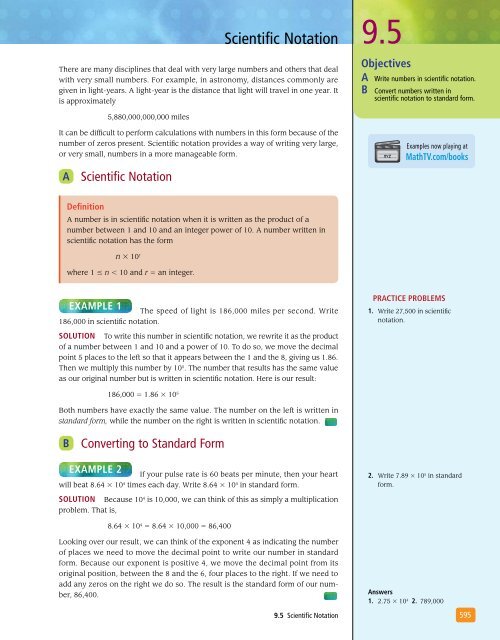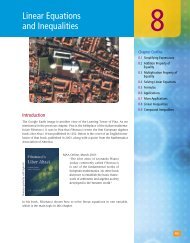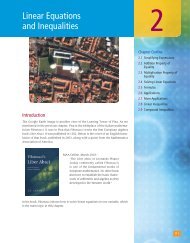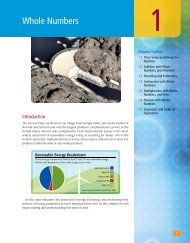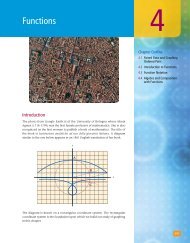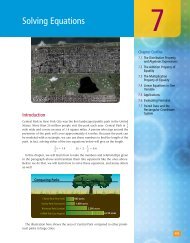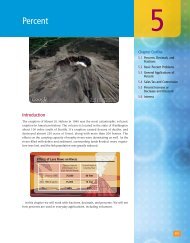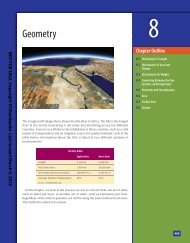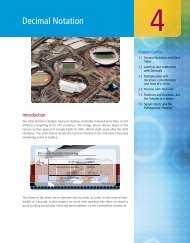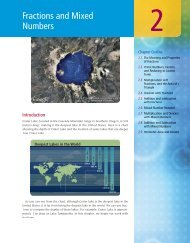Exponents and Polynomials - XYZ Custom Plus
Exponents and Polynomials - XYZ Custom Plus
Exponents and Polynomials - XYZ Custom Plus
- No tags were found...
Create successful ePaper yourself
Turn your PDF publications into a flip-book with our unique Google optimized e-Paper software.
Scientific NotationThere are many disciplines that deal with very large numbers <strong>and</strong> others that dealwith very small numbers. For example, in astronomy, distances commonly aregiven in light-years. A light-year is the distance that light will travel in one year. Itis approximately9.5ObjectivesA Write numbers in scientific notation.B Convert numbers written inscientific notation to st<strong>and</strong>ard form.5,880,000,000,000 milesIt can be difficult to perform calculations with numbers in this form because of thenumber of zeros present. Scientific notation provides a way of writing very large,or very small, numbers in a more manageable form.A Scientific NotationExamples now playing atMathTV.com/booksDefinitionA number is in scientific notation when it is written as the product of anumber between 1 <strong>and</strong> 10 <strong>and</strong> an integer power of 10. A number written inscientific notation has the formn × 10 rwhere 1 ≤ n < 10 <strong>and</strong> r = an integer.Example 1The speed of light is 186,000 miles per second. Write186,000 in scientific notation.Solution To write this number in scientific notation, we rewrite it as the productof a number between 1 <strong>and</strong> 10 <strong>and</strong> a power of 10. To do so, we move the decimalpoint 5 places to the left so that it appears between the 1 <strong>and</strong> the 8, giving us 1.86.Then we multiply this number by 10 5 . The number that results has the same valueas our original number but is written in scientific notation. Here is our result:Practice Problems1. Write 27,500 in scientificnotation.186,000 = 1.86 × 10 5Both numbers have exactly the same value. The number on the left is written inst<strong>and</strong>ard form, while the number on the right is written in scientific notation.BConverting to St<strong>and</strong>ard FormExample 2If your pulse rate is 60 beats per minute, then your heartwill beat 8.64 × 10 4 times each day. Write 8.64 × 10 4 in st<strong>and</strong>ard form.Solution Because 10 4 is 10,000, we can think of this as simply a multiplicationproblem. That is,2. Write 7.89 × 10 5 in st<strong>and</strong>ardform.8.64 × 10 4 = 8.64 × 10,000 = 86,400Looking over our result, we can think of the exponent 4 as indicating the numberof places we need to move the decimal point to write our number in st<strong>and</strong>ardform. Because our exponent is positive 4, we move the decimal point from itsoriginal position, between the 8 <strong>and</strong> the 6, four places to the right. If we need toadd any zeros on the right we do so. The result is the st<strong>and</strong>ard form of our number,86,400.9.5 Scientific NotationAnswers1. 2.75 × 10 4 2. 789,000595


